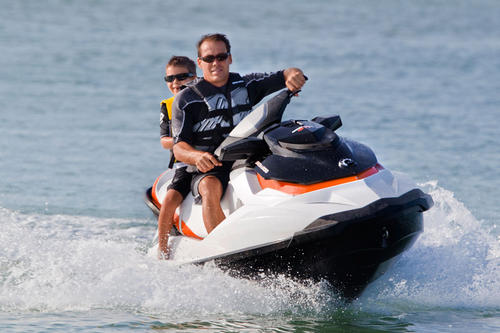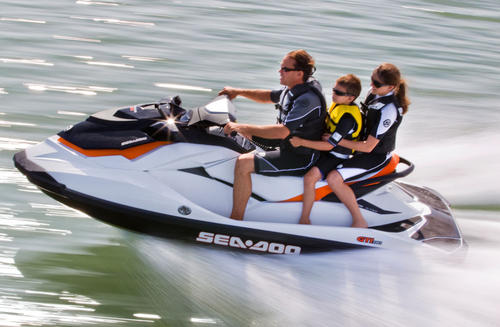2012 Sea-Doo GTI 130 Review
Nothing "base" about this entry-level PWC
The term “base” model doesn’t really do the Sea-Doo GTI 130 justice. Why? For starters, this is an entry-level boat with the ‘Doo’s much-heralded braking system. It’s also got other un-base-like amenities like electronic throttle, which allows for selectable acceleration profiles. Add in a competent, fun hull design and a level of style that suddenly rivals the brand’s flagships, and the only thing base-like about this boat…
…is its price.
Core Values
Let’s put those amenities aside for a moment, however, and consider the basic platform. Sea-Doo redesigned the GTI in 2011, keeping much of the familiar hull (shallower-than-normal 16 degree deadrise, predictable yet playful handling often lacking in today’s precision-handling market) but adding a new top deck that combines form and function. The form comes via a faceted design that ties in with the GTX line, yet gives the craft its own distinctive appearance. Fit and finish has also been raised to GTX standards.
Several features can sum up function. For starters, the boat is lower in height, a sleek design that also lowers the driver closer to the water and reduces the craft’s center of gravity. The saddle curves like an hourglass to avoid spreading the legs
 The GTI’s saddle curves like an hourglass so the rider’s legs don’t spread uncomfortably.
The GTI’s saddle curves like an hourglass so the rider’s legs don’t spread uncomfortably.uncomfortably wide. Footwells cant inward, reducing the strain on a rider’s knees and allowing the pilot to use them for leverage in a corner, and flow in a continuous curve to keep a foot in constant, secure contact. The info is moved forward to be better visible when a rider chooses to stand. It’s a comfortable, dialed-in position that would only be improved by tilt steering. Without it, standing left me with a slightly hunched-over feeling. I imagine taller riders will miss tilt even more.
The other half of that basic platform is a familiar engine. This is Sea-Doo’s Rotax 4-TEC in its 130 hp guise, able to push the craft to a speed of nearly 55 mph, haul up the skiers and wakeboarders in your crowd, and yet sip fuel at a miserly rate that won’t leave you dreading the gas bill. Sure, it’s not a 65 mph speedster, but it’s not meant to be. In this category, 55 is the target and Sea-Doo hits it.
Above and Beyond
 Sea-Doo’s iBR is not a feature you’d expect on an entry level craft.
Sea-Doo’s iBR is not a feature you’d expect on an entry level craft.So now back to those very un-base-like amenities. Sea-Doo’s Intelligent Brake & Reverse is by now well documented. It links a handlebar-mounted control lever to a dual-purpose reverse bucket at the pump nozzle. Start the craft and that bucket partially deploys to mimic a neutral setting and keep the boat stationary at the dock. Squeeze the reverse lever and you back away; grab the throttle and you move forward. It takes minutes to get the hang of, and keeps attention focused on the water.
And yes, it gives a boat brakes. Squeeze that lever at speed and the craft’s computer shuts off thrust for a split second, deploys that bucket, then reapplies the thrust before the rider even recognizes the change. Thrust is now redirected forward where it provides stopping power, slowing the craft to a stop in
 New for 2012 is ECO mode, which automatically chooses the optimal RPM for the best fuel economy.
New for 2012 is ECO mode, which automatically chooses the optimal RPM for the best fuel economy.about half the distance it would otherwise travel. That same computer also keeps the boat from slowing too abruptly to avoid launching said pilot over the handlebars. It’s sleek, it works, and it proves a valuable feature, especially for novice riders.
Electronic throttle is the other big-ticket amenity you don’t expect at the entry-level. Sea-Doo uses it to provide two primary acceleration profiles, a tamer Touring setting and a more aggressive Sport profile. A third setting, ECO, is new for 2012. In simple terms, it chooses the optimal RPM for greatest fuel economy.
All The Rest
Naturally, you also get the rest of the Sea-Doo standards, including dual lanyards that act as both a theft-prevention device and speed limiter, wide-angle mirrors, a 21-function info center, and 30-plus gallons of storage.
Add it all up and you’ve got a craft that offers a lot for the price, yet also manages to appeal to those who don’t worry about counting their pennies.
In other words, it’s an appealing choice…whatever your level.
| Sea-Doo GTI 130 Specs | |
| Length | 132.6 inches |
| Beam | 48.5 inches |
| Dry Weight | 755 lbs |
| Engine | Naturally aspirated three-cylinder |
| Displacement | 1,494 cc |
| Bore and Stroke | 100 mm x 63.4 mm |
| Compression Ratio | 10.6:1 |
| Fuel Capacity | 15.9 gal. |
| Combined Stowage Capacity | 30.8 gal. |
| Colors | Black and White |
| Price | $9,299 |
Related Reading
2012 Sea-Doo GTI SE 130 Review
2012 Sea-Doo GTS 130 Review
2012 Sea-Doo GTI Limited 155 Review
2012 Sea-Doo GTX S 155 Review
Get PersonalWatercraft.com in your Inbox!
Like PersonalWatercraft.com on Facebook
Comments
Most Popular

2025 Yamaha JetBlaster PRO 2-Up Review

Remembering the Sea-Doo XP

2024 Kawasaki Jet Ski STX 160X Review

2017 Kawasaki Jet Ski Ultra 310LX Review

Whatever Happened to the Wetbike?













 Your Privacy Choices
Your Privacy Choices